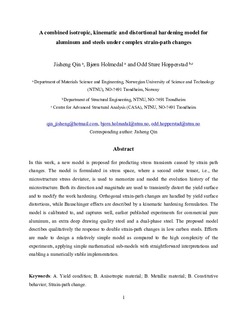| dc.contributor.author | Qin, Jisheng | |
| dc.contributor.author | Holmedal, Bjørn | |
| dc.contributor.author | Hopperstad, Odd Sture | |
| dc.date.accessioned | 2018-03-20T13:46:15Z | |
| dc.date.available | 2018-03-20T13:46:15Z | |
| dc.date.created | 2018-01-15T08:52:45Z | |
| dc.date.issued | 2018 | |
| dc.identifier.citation | International journal of plasticity. 2018, 101 156-169. | nb_NO |
| dc.identifier.issn | 0749-6419 | |
| dc.identifier.uri | http://hdl.handle.net/11250/2491299 | |
| dc.description.abstract | In this work, a new model is proposed for predicting stress transients caused by strain path changes. The model is formulated in stress space, where a second order tensor, i.e., the microstructure stress deviator, is used to memorize and model the evolution history of the microstructure. Both its direction and magnitude are used to transiently distort the yield surface and to modify the work hardening. Orthogonal strain-path changes are handled by yield surface distortions, while Bauschinger effects are described by a kinematic hardening formulation. The model is calibrated to, and captures well, earlier published experiments for commercial pure aluminum, an extra deep drawing quality steel and a dual-phase steel. The proposed model describes qualitatively the response to double strain-path changes in low carbon steels. Efforts are made to design a relatively simple model as compared to the high complexity of the experiments, applying simple mathematical sub-models with straightforward interpretations and enabling a numerically stable implementation. | nb_NO |
| dc.language.iso | eng | nb_NO |
| dc.publisher | Elsevier | nb_NO |
| dc.rights | Attribution-NonCommercial-NoDerivatives 4.0 Internasjonal | * |
| dc.rights.uri | http://creativecommons.org/licenses/by-nc-nd/4.0/deed.no | * |
| dc.title | A combined isotropic, kinematic and distortional hardening model for aluminum and steels under complex strain-path changes | nb_NO |
| dc.type | Journal article | nb_NO |
| dc.type | Peer reviewed | nb_NO |
| dc.description.version | acceptedVersion | nb_NO |
| dc.source.pagenumber | 156-169 | nb_NO |
| dc.source.volume | 101 | nb_NO |
| dc.source.journal | International journal of plasticity | nb_NO |
| dc.identifier.doi | https://doi.org/10.1016/j.ijplas.2017.10.013 | |
| dc.identifier.cristin | 1542377 | |
| dc.description.localcode | © 2017. This is the authors’ accepted and refereed manuscript to the article. Locked until 31.10.2019 due to copyright restrictions. This manuscript version is made available under the CC-BY-NC-ND 4.0 license http://creativecommons.org/licenses/by-nc-nd/4.0/ | nb_NO |
| cristin.unitcode | 194,66,35,0 | |
| cristin.unitcode | 194,64,45,0 | |
| cristin.unitname | Institutt for materialteknologi | |
| cristin.unitname | Institutt for konstruksjonsteknikk | |
| cristin.ispublished | true | |
| cristin.fulltext | postprint | |
| cristin.qualitycode | 2 | |

